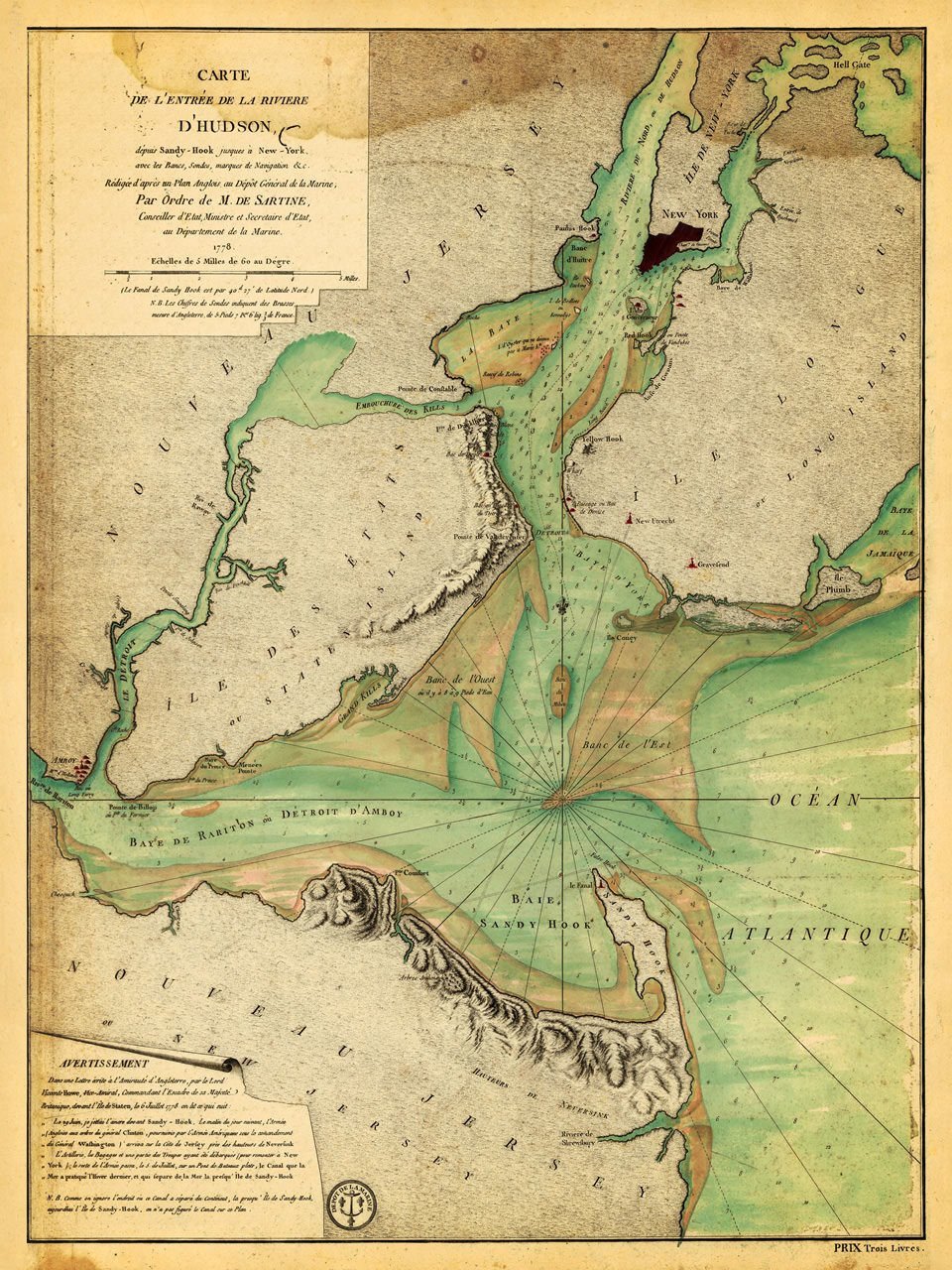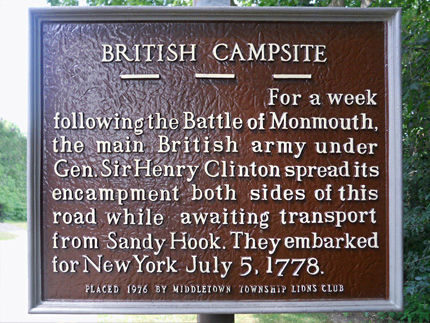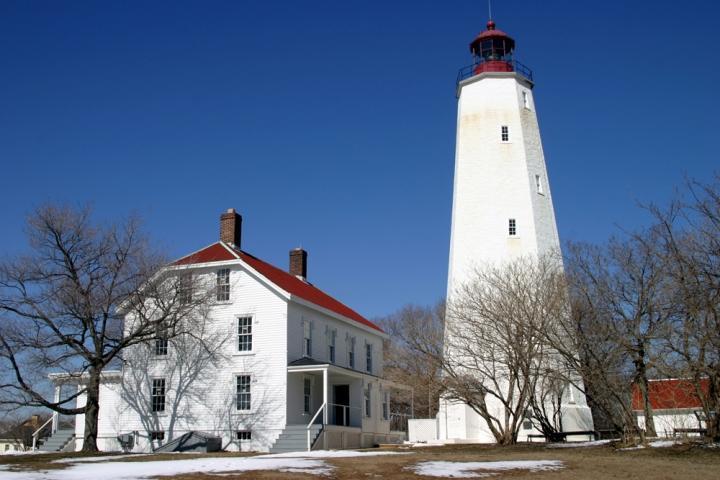The Highlands of Navasink and Sandy Hook played a vital and strategic roll in the American Revolutionary War for both the British and Colonial Armies.
When the British fleet arrived off Sandy Hook on Saturday, 29 June, 1776, sympathizers with the British cause, mainly from Monmouth County, fled to Sandy Hook via Highlands in large numbers. These so-called "Loyalists" built fortifications and with the help of the British, were able to hold Sandy Hook for the remainder of the Revolutionary War.
 ” New York, 1778, Hudson River, Sandy Hook, New Jersey, Revolutionary Era Map"
” New York, 1778, Hudson River, Sandy Hook, New Jersey, Revolutionary Era Map"
Perhaps the most widely known event relative to Sandy Hook, Highlands, and the Revolution happened during 1778 after Britain learned that France had acknowledged the independence of the young United States. At the time Britain had its main army divided between Philadelphia and New York and it was decided to consolidate these two forces at New York.
The British were short of ships and it was planned to march the Philadelphia force of over twelve thousand, across New Jersey to New York. General Sir Henry Clinton was in command of the army, which departed Philadelphia on 18 June, 1778.
General George Washington started in pursuit of Clinton with some of his force that same day from Valley Forge where they had spent their infamous harsh winter. The next day the entire American army of about the same size as the British, was on the march.
 ” British encampment sign"
” British encampment sign"
The two armies met at Freehold, now the Monmouth County Seat, where the important Battle of Monmouth was fought to a draw on Sunday, 28 June, 1778. After the battle, Clinton continued his journey through Monmouth by way of Middletown, then on toward Sandy Hook. On top of Chapel Hill, and from the Navesink River to Sandy Hook Bay, Clinton deployed his force while a pontoon bridge was being built from the Gravelly Point section of Highlands across the tidal stream at the base of Sandy Hook.
On 5 July, 1778, a week after the battle, as recorded in General Clinton's own narrative of the war, "the King's army descended from the High (lands) of Navesink, where I caused them to encamp, and embarking in transports (off Horse Shoe Cove) were conveyed to their respective stations on Staten, York, and Long Islands."
 ” Sandy Hook Lighthouse"
” Sandy Hook Lighthouse"
The Loyalists stayed in control of Sandy Hook even after the war was ended by the surrender of Cornwallis at Yorktown on 19 October, 1781.
Sandy Hook includes the oldest surviving lighthouse in what is now the United States. Built in 1764, it is still in use today. The British Army captured the lighthouse in 1776 and held it until the evacuation of New York in 1783. At least once the Continental Army tried to knock it down.
The Loyalists waited there on the Hook until the following year when they sought refuge in New York City, which was still occupied by the British until the American Revolution was ended by the Treaty of Paris on 3 September, 1783.
NJ's Revolutionary hero ~ Captain Joshua Huddy
Highlands had its own Revolutionary hero, Capt. Joshua Huddy. He was the eldest of seven brothers, a member of the Monmouth County branch of the Continental Militia and a great hunter of the gangs of Tory (Loyalist) refugees who plundered this whole section of the state in their search for American rebels. They made him a particular target of their detestation and several times laid plans to kill him. In 1780, on one of the Loyalists' many raids from Sandy Hook, one of these plans practically succeeded when they set fire to his home in Colts Neck. Huddy, who was within and armed, agreed to surrender if they would help him to put out the fire. They did agree and started off with Huddy as a prisoner; but the burning house had attracted the attention of his neighbors, who sent for help to the nearest guard station, whereupon the local militia all took their guns down from the mantelpiece and boiled out in pursuit. They overtook the vengeful Tories before they reached their boats at Black Point, Rumson, and during the row, Huddy knocked out the man who was holding him, jumped overboard, and escaped.
Two years later the Loyalists caught up with him during a raid and minor battle at the salt works at Toms River, then known as Dover. Huddy was carried off to the Sugar-House Prison in New York City and then transferred in irons to a guard ship at Sandy Hook where the British held him for a short time. On 12 April, 1782, a party of Tories carried him to Gravelly Point - Highlands - where he was allowed to write his will. Charged with having cruelly put to death one Captain Philip White, Captain Joshua Huddy was hanged. (Philip White had been captured by rebels earlier in Long Branch and shot while being transported to Freehold. Huddy was not involved in the shooting, having been in a British prison at the time, but was hanged merely as an expression of retaliation). Huddy's body was found by a party of patriots, who carried it to Freehold and buried it there.
General George Washington, when told of the hanging, demanded the British turn over to him Captain Richard Lippencott, a Monmouth County Loyalist said to be responsible for the hanging. This demand was refused and a substitute was offered, who was later released as a "humanitarian act" of the Continental Congress.
A monument bearing a plaque to Captain Joshua Huddy now stands in a small park which bears his name at the foot of Water Witch Avenue in the Highlands near the spot where he was hanged.
This cache is one of "The American Revolution Geo~Trail" caches throughout New Jersey. These special geocaches are hidden at historic locations which have a connection to important New Jersey's American Revolutionary War history. To participate in the optional Geo-Trail, after you find the geocache, locate the secret code and record it into your passport which you will print from the Geo~Trail website. Information at njpatriots.org
NOTE: All Geo-trail participants, This Cache Location is a Must DO and Photo Requirement.
 ”njpatriots.org"
”njpatriots.org"
The Northern New Jersey Cachers, NNJC is about promoting a quality caching experience in New Jersey. For information on The Northern New Jersey Cachers group you can visit: www.nnjc.org.
 nnjc.org & metrogathering.org, & njpatriots.org
nnjc.org & metrogathering.org, & njpatriots.org